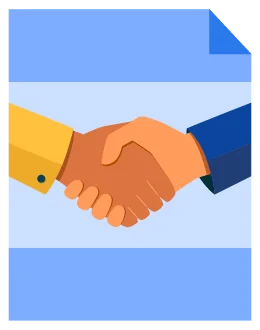Congratulations! You just closed a deal, but now, the real work begins. Kick-start your customer’s journey the right way with our downloadable sales handoff template.
We created our sales handoff template to help you overcome one of the most challenging parts of customer onboarding: ensuring that the customer implements your solution smoothly with their existing workflow. To help facilitate that transition, you need a sales handoff process to connect your customers with their designated customer success manager (CSM).
In this post, we’ll discuss:
- What is a sales handoff?
- The 10 steps in a sales handoff process
- Our handoff meeting script

Download the Sales Handover Template
Use our sales handoff template to help your customers maximize the utility of your solution right away.
What is a Sales Handoff?
A sales handoff (also known as a warm handoff or sales handover) is the process of connecting a new customer to their CSM to establish their relationship. This gives the customer a designated person within your company to contact, which is crucial to help address future roadblocks.
As mentioned previously, a sales handoff empowers your customers to maximize your solution from day one. There are actually more benefits to creating your sales handoff process:
- You’re building off of the momentum between the salesperson and the customer
- You’re giving your customers a designated subject matter expert to contact moving forward
- You’re actively ensuring that your customers are satisfied with your solution right off the bat
- You can address any initial red flags immediately
EBQ Tip: When you download our template, you can actually adapt it to other handoff conversations, such as:
- Transferring a prospect from an SDR to an AE
- Introducing the customer to their new CSM before their existing CSM transitions out of the organization
- A receptionist transfers a call to the appropriate point of contact
In other words, use our template as a starting point to guide conversations with a prospect/customer from one team member to another.

Subscribe to EBQ's Bimonthly Newsletter

Subscribe to EBQ's Bimonthly Newsletter
The 10 Steps in a Sales Handoff Process
We’ll be separating our sales handoff process into three distinct phases: before the kickoff meeting, during the kickoff meeting, and after the kickoff meeting.
All in all, the 10 steps of a sales handoff process are:
- Invest in a single source of truth
- Schedule the meeting
- Send out a meeting confirmation with the meeting agenda
- Prepare for the meeting
- Start the meeting with the salesperson
- Establish an onboarding plan
- Address initial red flags and road bumps
- Send a meeting recap and relevant handouts
- Schedule regular check-ins
- Update your CRM
Before the Kickoff Meeting
During this phase, your team needs to document and review all interactions between your organization and your new customer from their first interaction to closing the deal.
1. Invest in a single source of truth
At this point, you should have a CRM — such as Salesforce — that tracks every touchpoint between your customer and your brand. An instance is crucial to get historical data for research purposes and it helps your team prepare for the meeting (more on that later).
If you have a new CRM, you need a professional to help you migrate legacy data, create logical automation, and design dashboards to help you visualize your customer journey. Our certified CRM administrators are trained to help customize your robust instance to suit your business requirements. Visit our CRM Implementation Services page to learn how we’ve empowered thousands of organizations to maximize their instance.
2. Schedule the meeting
For the warm handoff to work, both your salesperson and your CSM need to attend the kickoff meeting. As a best practice, make sure both your salesperson and your CSM can access each other’s calendars to schedule meetings during the closing call.
Typically, we recommend your kickoff meeting to last anywhere from 45 minutes to 1 hour long. That way, your CSM can go through the demo and answer any questions your customers may have without feeling overwhelmed or rushed.
3. Send out a meeting confirmation with the meeting agenda
As soon as the kickoff meeting is scheduled, make sure your salesperson emails your customer a meeting confirmation with an agenda.
That way, your customer has adequate time to prepare for the meeting and come up with a list of questions to ask during the call.
4. Prepare for the meeting
The best way to leave a great impression is to look prepared and committed to the customer. Both your CSM and your salesperson need to review historical data to make sure they’re on the same page before the call — which is where your CRM will come into play.
Some of the things they should review include:
- Company name
- Customer name and job title
- Biggest pain points
- What drew them into your solution
- How the salesperson pitched your solution
During the Kickoff Meeting
Remember: You’ve convinced the customer to buy into your solution. They already know you can provide value to their business. Now, it’s time to continue building off of the momentum to create a long-lasting relationship.
5. Start the meeting with the salesperson
To ease into the kickoff meeting, your salesperson should be the one starting the meeting and introducing everyone to each other. That’s because the customer already has an established relationship with the salesperson; they trust the salesperson to know their pain points and how the solution works.
We’ll include a script our salespeople use later in the article to dive into how our team starts a handover meeting.
6. Establish an onboarding plan
During the call, the CSM should have a presentation on what the customer should expect during their first month of using your solution.
Other things to consider including in your onboarding plan:
- How to set up your solution (e.g. account setup and hardware set)
- Establishing a point of contact for both the customer and your organization
- Your plan of action to make sure your customer feels comfortable with your product
- Restating the scope of your project and managing expectations
- How success will be measured to evaluate ROI
7. Address initial red flags and road bumps.
Save the final 15 to 20 minutes of your kickoff meeting to address any questions your customers have. Not only can you address the first roadblocks, but you can also look more professional right off the bat.
After the Kickoff Meeting
Now that you have started the relationship with the customer on the right path, it’s time to continue delighting your customers to increase their CLV. At this point, you should be focusing on establishing a back-and-forth communication feedback loop.
8. Send a meeting recap and relevant handouts
Shortly after the kickoff meeting, your CSM should send out a meeting recap and attach relevant handouts to your customers. Make sure to thank the customer for their time and invite them to continue sending over any questions they may have.
We also recommend CC’ing your salesperson for visibility. That way, your salesperson can help resend the email should the first email land in the customer’s spam folder.
9. Schedule regular check-ins.
At EBQ, we like to schedule biweekly continuous improvement meetings (CIMs) with our customers. This meeting should include all management stakeholders to evaluate the current health of the partnership.
Your onboarding plan should include an omnichannel feedback loop. From our experience, asking people for feedback is the best way to demonstrate how you truly care for the customers — which increases the level of trust from the customer.
10. Update your CRM
Make sure to document all of the feedback in a centralized location. That way, your customer success team can review the feedback and draw data-driven conclusions on how to improve future onboarding plans.
If you want a more in-depth guide on how to boost customer satisfaction, check out our Ultimate Guide to B2B Customer Service Strategy. We dive into what your customer success team should comprise, how to properly onboard a customer, and how to retain dissatisfied customers.
Our Handoff Meeting Script
In step 5, we mentioned how the salesperson should kick off the meeting. One of the most challenging aspects of the kickoff meeting is to set the right tone for the rest of the call.
Here is how our salespeople would perform a warm handoff:
“Hi [CUSTOMER NAME],
Thank you for joining the call today. Before we get started, Is there anyone else that may be joining on your side that we should wait for?”
(If Yes)
“Okay, we can give them a few minutes to join.”
Exchange pleasantries but keep it high level (i.e. Ask about their week, talk about the weather, etc.)
(If No)
“Okay, that sounds good. We appreciate your time today [CUSTOMER NAME], I have [CSM Name] here who will be leading our call. I’ve spoken with them about our initial call already, but if you wouldn’t mind introducing yourself and your role at [CLIENT CUSTOMER NAME].”

Download the Sales Handover Template
Use our sales handoff template to help your customers maximize the utility of your solution right away.
Perfecting the warm handoff with our template
Thanks for downloading our sales handoff template! In this post, we’ve discussed the ten steps to a proper sales handover meeting, which are:
- Invest in a single source of truth
- Schedule the meeting
- Send out a meeting confirmation with the meeting agenda
- Prepare for the meeting
- Start the meeting with the salesperson
- Establish an onboarding plan
- Address initial red flags and road bumps
- Send a meeting recap and relevant handouts
- Schedule regular check-ins
- Update your CRM
Most business leaders recognize the importance of a strong customer relationship for improved retention, but many struggle with finding the right representatives to foster that relationship. Our Customer Experience Team can handle everything from onboarding to continuing care so you can focus on your core business functions. Visit our Customer Experience Outsourcing page to learn more about our services.


